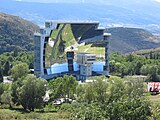Technogaianism
This article may be unbalanced towards certain viewpoints. (April 2016) |
| Transhumanism |
|---|
 |
| Concepts |
|
| Subsets of Transhumanism |
|
| Political ideologies |
|
Technogaianism (a
Philosophy
This point of view is different from the default position of
While many environmentalists[
Sociologist
The theories of English writer Fraser Clark may be broadly categorized as technogaian. [according to whom?] Clark advocated "balancing the hippie right brain with the techno left brain". The idea of combining technology and ecology was extrapolated at length by a South African eco-anarchist project in the 1990s. The Kagenna Magazine project aimed to combine technology, art, and ecology in an emerging movement that could restore the balance between humans and nature.
Methods
Environmental monitoring
Technology facilities the sampling, testing, and monitoring of various environments and ecosystems. NASA uses space-based observations to conduct research on solar activity, sea level rise, the temperature of the atmosphere and the oceans, the state of the ozone layer, air pollution, and changes in sea ice and land ice.[6]
Geoengineering
Climate engineering is a technogaian method that uses two categories of technologies-
Earthquake engineering is a technogaian method concerned with protecting society and the natural and man-made environment from earthquakes by limiting the seismic risk to acceptable levels.[7] Another example of a technogaian practice is an artificial
Genetic engineering
S. Matthew Liao, professor of philosophy and bioethics at New York University, claims that the human impact on the environment could be reduced by genetically engineering humans to have, a smaller stature, an intolerance to eating meat, and an increased ability to see in the dark, thereby using less lighting.[10] Liao argues that human engineering is less risky than geoengineering.[11]
Genetically modified foods have reduced the amount of herbicide and insecticide needed for cultivation. The development of glyphosate-resistant (Roundup Ready) plants has changed the herbicide use profile away from more environmentally persistent herbicides with higher toxicity, such as atrazine, metribuzin and alachlor, and reduced the volume and danger of herbicide runoff.[12]
An environmental benefit of Bt-cotton and maize is reduced use of chemical insecticides.
Examples of implementation
-
Biosphere 2 sits on a sprawling 40-acre (16-hectare) science campus that is open to the public.
-
Panoramic view of the geodesic biome domes at the Eden Project
-
An artist's conception of ahuman Mars base, with a cutaway revealing an interior horticultural area
-
ThePyrenees-Orientalescan reach temperatures up to 3,500°C.
-
ThePS10 Solar Power Plant concentrates sunlight from a field of heliostatsonto a central solar power tower.
-
photovoltaicpower plant in North America when built.
-
Offshore wind farm near Copenhagen, Denmark
-
Deep Space Climate Observatory, designed to give an early warning of approaching solar storms
Related environmental ethical schools and movements
- Biopunk/Do-it-yourself biology
- Solarpunk
- Bright green environmentalism
- Biomimetics
- Communalism
- Eco-communalism
- Prometheanism
- Reconciliation ecology
- Social ecology
- The Zeitgeist Movement
- Viridian design movement
See also
References
- ^ ISBN 0-8133-4198-1.
- ^ ISBN 0-19-515604-8.
- ISBN 0-15-190483-9.
- ^ Sterling, Bruce (2001). "Viridian: The Manifesto of January 3, 2000". Retrieved 2007-01-28.
{{cite journal}}: Cite journal requires|journal=(help) - ^ a b c George Dvorsky, 7 Best-Case Scenarios for the Future of Humanity, Sentient Developments, (Feb. 2, 2013).
- ^ Global Climate Change: Vital Signs of the Planet: NASA's Role, Taking a global perspective on Earth's climate
- ISBN 978-0-8493-1439-1.
- ISBN 0-415-29998-5.
- ISBN 0-684-83550-9
- ^ Ross Anderson, How Engineering the Human Body Could Combat Climate Change, The Atlantic, (March 12, 2012).
- ^ S. Mathew Liao, Human Engineering and Climate Change, (Feb. 12, 2012).
- PMID 18268303.
- PMID 18051264.
- S2CID 23172622.
- ^ Brookes, Graham & Barfoot, Peter (2008) Global Impact of Biotech Crops: Socio-Economic and Environmental Effects, 1996-2006 AgBioForum, Volume 11, Number 1, Article 3. Retrieved 12 August 2010
- .
- ^ Kovach J, Petzoldt C, Degni J, Tette J. "A Method to Measure the Environmental Impact of Pesticides". New York State Agricultural Experiment Station. Retrieved 23 November 2008.
- ^ Carrington, Damien (13 June 2012) GM crops good for environment, study finds The Guardian. Retrieved 16 June 2012
- S2CID 4415298.
- ^ Jan Suszkiw (November 1999). "Tifton, Georgia: A Peanut Pest Showdown". Agricultural Research magazine. Archived from the original on 12 October 2008. Retrieved 2008-11-23.




![Bt toxins present in peanut leaves (bottom image) protect it from extensive damage caused by lesser cornstalk borer larvae (top image).[20]](http://upload.wikimedia.org/wikipedia/commons/thumb/1/1d/Bt_plants.png/93px-Bt_plants.png)




